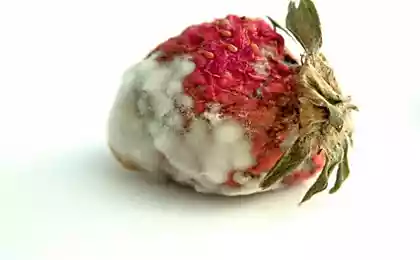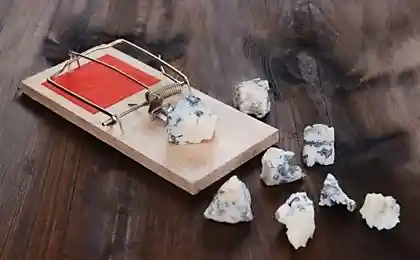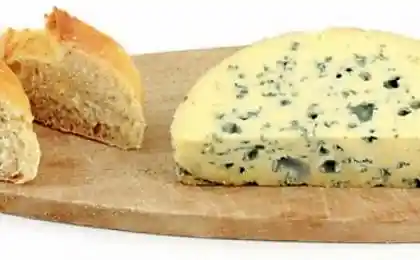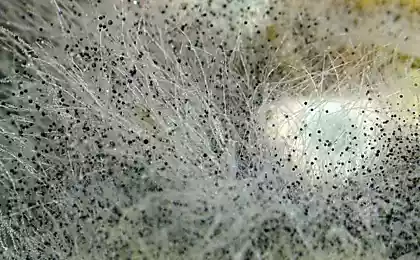498
Useful mold
Claviceps Purpurea
This fungus grows and develops on rye spikelets, as well as products obtained from rye (feed, seed). If you eat a little bit of rye grains infected with the fungus, you will start to not weak "flatten" want to dance, move, have fun. Perhaps a burning sensation in extremities. This is due to the action of specific alkaloids, which lead to a narrowing of blood vessels, which may in some cases over gangrene due to impaired circulation. Also available are similar to epileptic seizures. Scientists have shown that a large number of accusations of witchcraft in the Middle Ages were the cause is eating rye bread from moldy grain. And this fungus can produce LSD, but that's another story ...
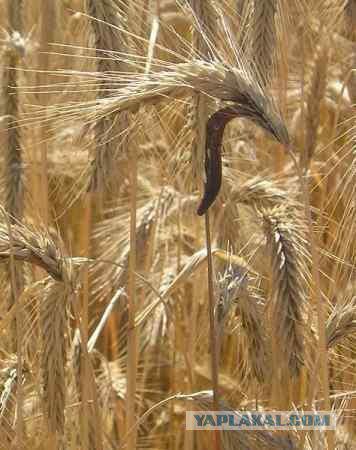
Omphalotus Olearius
This interesting mushroom can have a variety of colors - from orange to yellow, and looks very similar to ordinary chanterelles, but the difference is visible to the naked eye in the dark - it glows. One of the interesting names of this fungus - Jack o'Lantern, ie approximately lamppost mushroom Now the bad news. This fungus, unlike chanterelles, poisonous, and if a person unknowingly used it in food, the various troubles like colic, vomiting and diarrhea are provided. Fortunately, death is unlikely. The most interesting thing is that this mushroom looks very appetizing and smell had also very edible, so people often manage to poison him twice!
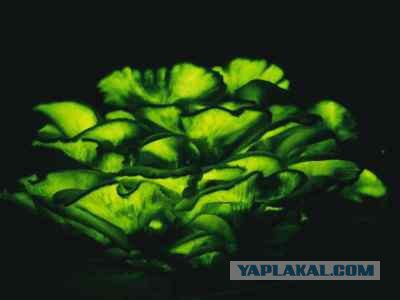
Cordyceps Sinensis
This fungus is very aggressive - he is a product of the strange symbiosis of caterpillars and fungi. It is found at an altitude of 3000-5000 meters above sea level in the Himalayas and Tibet. Its spores penetrate the caterpillars species Thitarodes and begin to actively grow. The mycelium fills the cavity inside the caterpillar and kills her mummified. Then, from the front of the caterpillar grows Stipe, reaching a height of 15 centimeters, extending around the disputes that are waiting for their owners. I would not close this fungus came up, and he turns out to be very much appreciated in the Tibetan and Chinese medicine, where it is used as an aphrodisiac and as a cure for various ailments from fatigue to cancer.
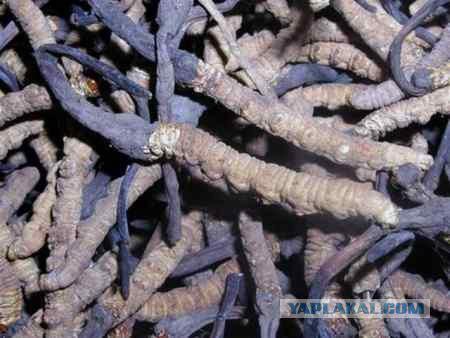
Trametes Versicolor
This type of fungus Trametes, its name translates as "many colors", and rightly so, because the color of Figaro actually be from purple to green and brown. In America it is called "turkey tail" because of its similarity to the object In Europe and Japan, polysaccharide-K (trade name Krestin), derived from this mushroom, has been used successfully in medicine to fight cancer. Its effect is not directly related to the healing of cancer, but the complex is a substance increases the effectiveness of other anticancer agents. Recent research has also shown its effectiveness in the treatment of AIDS.

Penicillium Roqueforti
The most common use of this fungus - production of blue cheeses, fragrances, antifungal agents, proteases, and other nutrients. This fungus is responsible for the appearance of mold on the elite cheeses such as Roquefort and Stilton. By the way, kind of blue cheese with a mold known to mankind for about 2,000 years. The classic recipe for this fungus fresh bread left in the cave for 6-8 weeks, so that he was covered with a layer of mold. Thereafter, the bread is dried and ground and the resulting powder was added into the cheese. Now this fungus obtained in the laboratory and then in the form of powder or aerosol is added to the curd from which cheese is subsequently derived.
Source

Source:
This fungus grows and develops on rye spikelets, as well as products obtained from rye (feed, seed). If you eat a little bit of rye grains infected with the fungus, you will start to not weak "flatten" want to dance, move, have fun. Perhaps a burning sensation in extremities. This is due to the action of specific alkaloids, which lead to a narrowing of blood vessels, which may in some cases over gangrene due to impaired circulation. Also available are similar to epileptic seizures. Scientists have shown that a large number of accusations of witchcraft in the Middle Ages were the cause is eating rye bread from moldy grain. And this fungus can produce LSD, but that's another story ...

Omphalotus Olearius
This interesting mushroom can have a variety of colors - from orange to yellow, and looks very similar to ordinary chanterelles, but the difference is visible to the naked eye in the dark - it glows. One of the interesting names of this fungus - Jack o'Lantern, ie approximately lamppost mushroom Now the bad news. This fungus, unlike chanterelles, poisonous, and if a person unknowingly used it in food, the various troubles like colic, vomiting and diarrhea are provided. Fortunately, death is unlikely. The most interesting thing is that this mushroom looks very appetizing and smell had also very edible, so people often manage to poison him twice!

Cordyceps Sinensis
This fungus is very aggressive - he is a product of the strange symbiosis of caterpillars and fungi. It is found at an altitude of 3000-5000 meters above sea level in the Himalayas and Tibet. Its spores penetrate the caterpillars species Thitarodes and begin to actively grow. The mycelium fills the cavity inside the caterpillar and kills her mummified. Then, from the front of the caterpillar grows Stipe, reaching a height of 15 centimeters, extending around the disputes that are waiting for their owners. I would not close this fungus came up, and he turns out to be very much appreciated in the Tibetan and Chinese medicine, where it is used as an aphrodisiac and as a cure for various ailments from fatigue to cancer.

Trametes Versicolor
This type of fungus Trametes, its name translates as "many colors", and rightly so, because the color of Figaro actually be from purple to green and brown. In America it is called "turkey tail" because of its similarity to the object In Europe and Japan, polysaccharide-K (trade name Krestin), derived from this mushroom, has been used successfully in medicine to fight cancer. Its effect is not directly related to the healing of cancer, but the complex is a substance increases the effectiveness of other anticancer agents. Recent research has also shown its effectiveness in the treatment of AIDS.

Penicillium Roqueforti
The most common use of this fungus - production of blue cheeses, fragrances, antifungal agents, proteases, and other nutrients. This fungus is responsible for the appearance of mold on the elite cheeses such as Roquefort and Stilton. By the way, kind of blue cheese with a mold known to mankind for about 2,000 years. The classic recipe for this fungus fresh bread left in the cave for 6-8 weeks, so that he was covered with a layer of mold. Thereafter, the bread is dried and ground and the resulting powder was added into the cheese. Now this fungus obtained in the laboratory and then in the form of powder or aerosol is added to the curd from which cheese is subsequently derived.
Source

Source:
